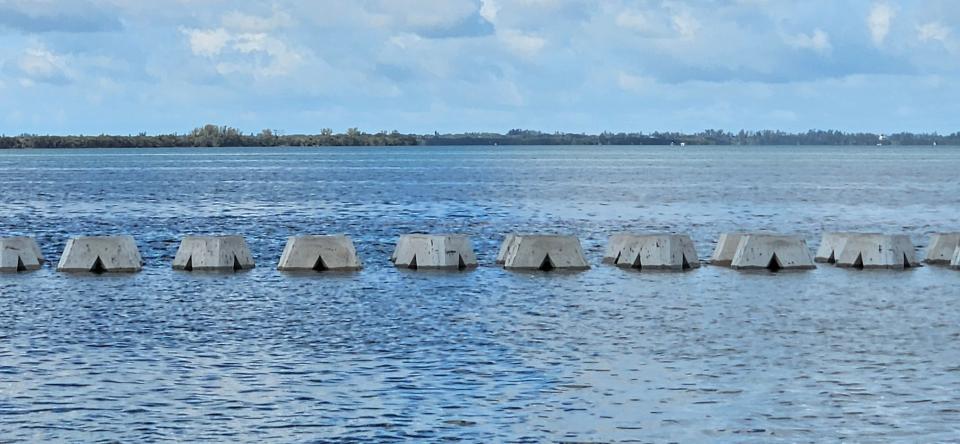What are those hundreds of concrete pyramids doing at the Skyway bridge fishing pier?

The Florida Department of Transportation is placing hundreds of wave attenuation devices to protect the south Skyway Fishing Pier access road from erosion, promote seagrass growth and create fish habitats.
But some environmentalists take issue with impact credits received by the agency for the project.
FDOT will place 844 wave attenuation devices, also referred to as WADs, along the shoreline to protect the fishing pier access road, which provides access to I-275. The $6.3 million project will be completed by the end of summer.
What are the devices made of?
The devices are made from fiber-reinforced concrete. Their triangular shape, weight, and size are designed to absorb wave energy during storms to protect the fishing pier access road from erosion. They will be strategically placed to protect also protect about eight acres of sea grass and create a habitat for fish.
"We know that this project is going to do wonders for this area, in terms of protecting the shoreline and really making this area resilient to future storm events and protecting I-275 making sure that it has access immediately after storm events," FDOT District Drainage Design Engineer Brent Setchell said during a news conference on Wednesday.

The devices will be visible about two to three feet above the water and will be placed so close together that boats or large marine animals would need to go around them to traverse.
"Boats really can't go between them. Fish can swim through them but larger, let's say a manatee or something would need to go around the outside to be able to get through," Setchell said. "There is an opening between the shoreline and where the WADs will be placed for wildlife to get through."
Related: Bradenton Beach joins lawsuit pushing for alternative to taller Cortez Bridge
Setchell said protecting the eight acres of sea grass will provide the agency with environmental impact mitigation credits that will be used to offset the impact of incoming bridge replacements to Anna Maria Island in Manatee County.
Concern from environmentalists
Manasota-88 Chairman Glenn Compton said the organization is concerned that the project could lead to overfishing in the area, and add to the impact the Sunshine Skyway Bridge has had on the local ecosystem. The nonprofit organization has advocated for environmental protection throughout the Manatee and Sarasota County region for more than 50 years.

"During the construction of the Skyway bridge, significant destruction was done to the seagrasses and marine resources of Tampa Bay," Compton said. "The proposed wave attenuation project does not come close to repairing the damage that has previously been done to the Bay as a result. FDOT needs to demonstrate overfishing would not occur as a result of placing the wave attenuation devices near the fishing pier, they have yet to do so."
Also: County OKs Carlos Beruff proposal for up to 5,378 residential units in East Manatee
Compton said he believes FDOT should not receive mitigation credits as a result of the project.
"FDOT does not do environmental restoration projects unless they can get mitigation credits for impacting wetlands elsewhere," he said. "Although it may make sense to protect existing infrastructure from wave erosion, it would be improper to grant FDOT any mitigation credit so they can do wetland destruction at another location."
This article originally appeared on Sarasota Herald-Tribune: Sunshine Skyway bridge fishing pier pyramids designed to curb erosion

